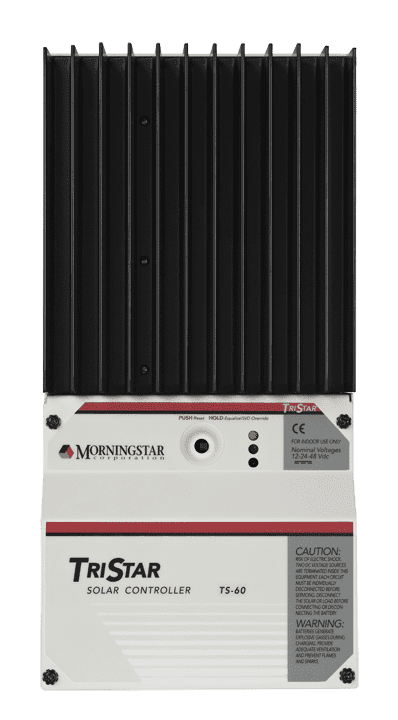No products in the cart.
Convenient Pick-Up at Over 10 Locations Nationwide
Need help? Call us:
+1 1800 212 3434
Morningstar TriStar TS-60 60A PWM Charge Controller
$319.80
19 people are viewing this product right now
Morningstar, TriStar Charge Controller, 60A, 12/24/48VDC, TS-60
Morningstar’s TriStar TS-60 PWM charge controller is a three-in-one solution for solar battery charging, load monitoring, and diversion regulation. At any given time, the controller is in one of these modes, and two or more controllers may be used to perform different functions.
The TriStar TS-60 has a constant voltage series PWM configuration for highly efficient battery charging; 4-stage charging (a bulk charge, PWM regulation, float, and equalize) to improve battery power and life; parallel for larger solar arrays up to 300 amps or more. TriStar starts large loads, such as motors and pumps, without causing harm to the controller; makes inrush current up to 300 amps; electronic short-circuit and overload safety with automatic reconnect; LVD is currently compensated and has a delay to prevent false disconnects. TriStar can be used as a diversion control for solar, wind, or hydroelectric power. Excess energy is redirected from the battery to an alternative DC resistive load to protect against battery overcharge; PWM reduces power to the diversion load during overcurrent conditions.
To include innovative new features at a competitive price, the TriStar employs advanced technology and automated manufacturing. The TriStar meter, which is available as an option, is the most sophisticated and insightful controller meter on the market. The controller is UL classified and can be used for both residential and commercial solar systems.
Features
- Highest Reliability, More Power & Better Battery Charging – Operating at maximum ratings to 60°C is possible thanks to the large heat sink and conservative nature. There’s no need to lower the rating. Solar arrays up to 4kW can be driven with 60A at 48VDC. The sensitivity of the control can be enhanced by connecting the battery sense wires and the optional remote temperature sensor. The constant voltage sequence PWM algorithm extends the power and life of the battery.
- Communications, Electronic Protections & Simple Mechanical Interface – Custom settings, data logging, and remote monitoring and control are all possible with RS-232. Low Telecom Noise: Changing the DIP switch to “On-Off” battery charging would minimize telecom noise. Reverse polarity, short circuit, overcurrent, high temperature, and overvoltage are all completely covered. Conduit knockouts and larger power terminals. There’s more space for wire turns. Fits on electrical panels.
- Fully Adjustable, Easy to Reset & Better Information – Via an RS-232 DIP switch, the user can choose from seven different digitals presets and custom settings. Manual reset, stop/start battery equalization, and load disconnect are all available via the pushbutton. Status, defects, and warnings are all indicated by three LEDs. A meter with extensive device and controller details, as well as automatic self-test and reset capabilities, is available as an option. The RJ-11 phone jack is used to attach the meter.
| Weight | 4.5 lbs |
|---|---|
| Dimensions | 12.5 × 7.5 × 3.5 in |
| MPN | TS-60 |
Related products
Fronius 4,240,153 DUO Rapid Shutdown Box, Single/Dual String
Balance of Systems, Battery-Based Inverters, Clearance Products, ENERGY STORAGE, Energy Storage Accessories, Energy Storage Miscellaneous, Lithium Iron Phospate
SolarEdge BI-NUSGN-02 Energy Hub Backup Interface
Balance of Systems, Boxes & Enclosures, Electrical, Energy Storage Accessories, Power Distribution, Surge Devices
Schneider Electric – SC42M200PS – All in one, Homeline
Morningstar GenStar GS-MPPT-60...
$1,295.00
SCHNEIDER 865-1060-01 AUTOMATI...
$295.00 Original price was: $295.00.$275.50Current price is: $275.50.
This website uses cookies to improve your experience.
By using this website you agree to our Privacy Policy.
By using this website you agree to our Privacy Policy.
Ok, I am ready
